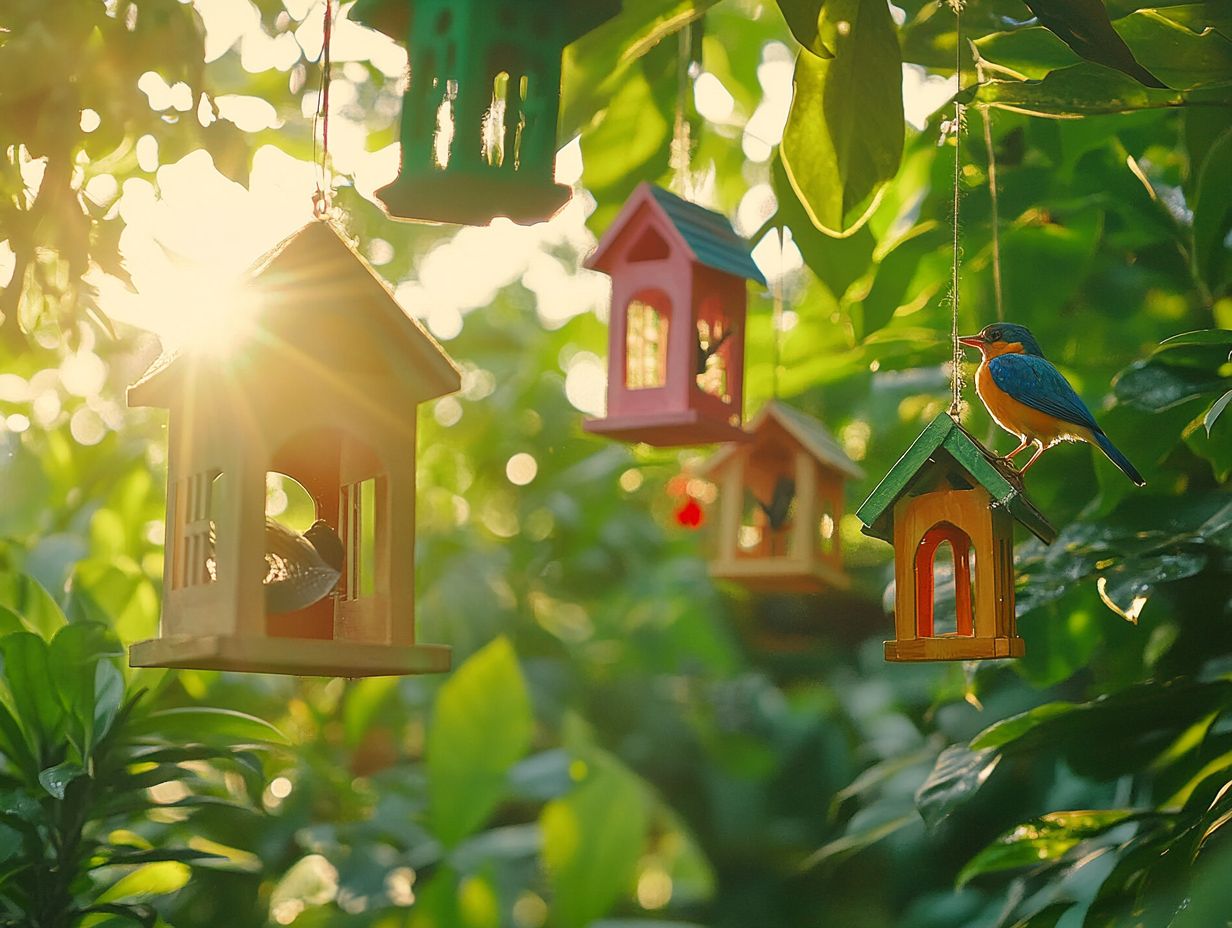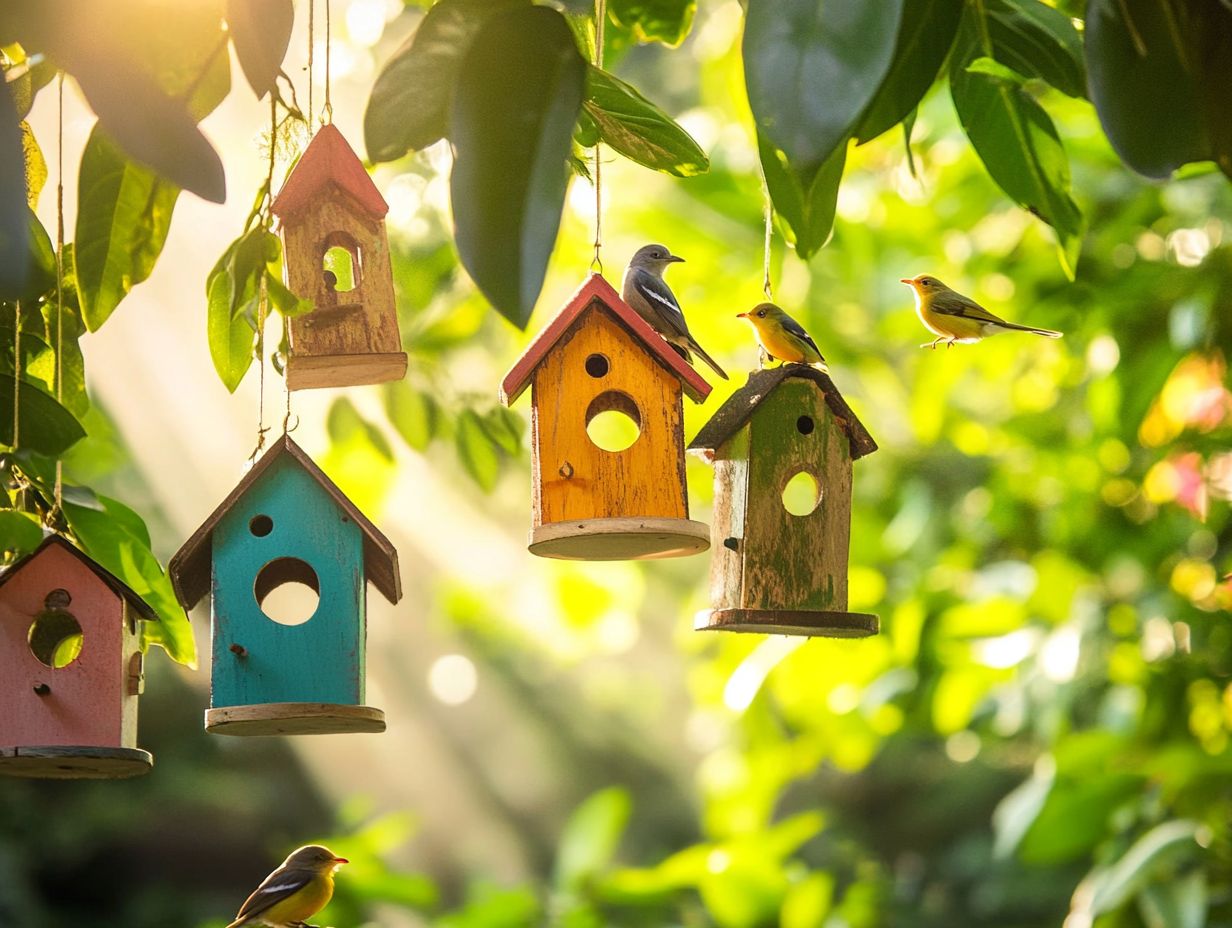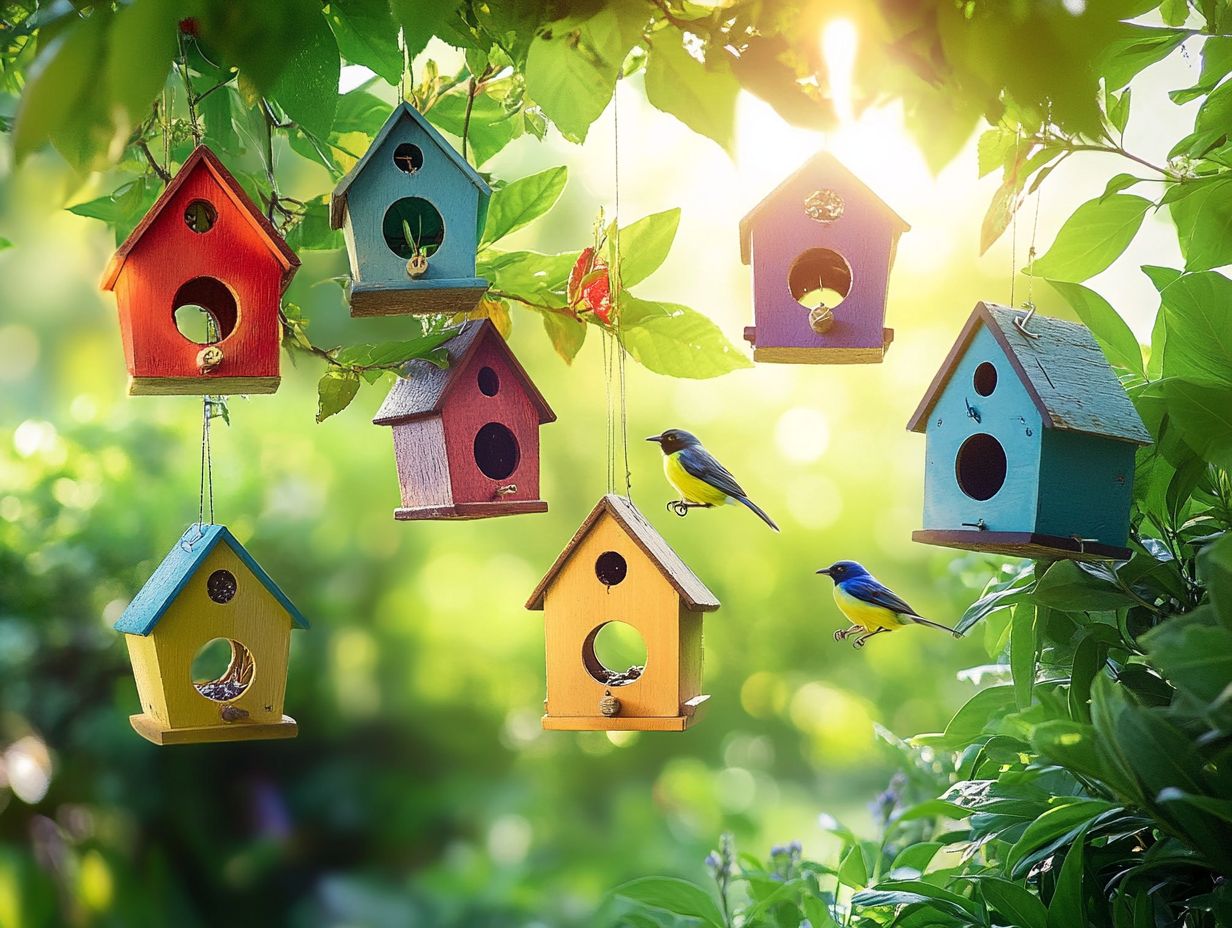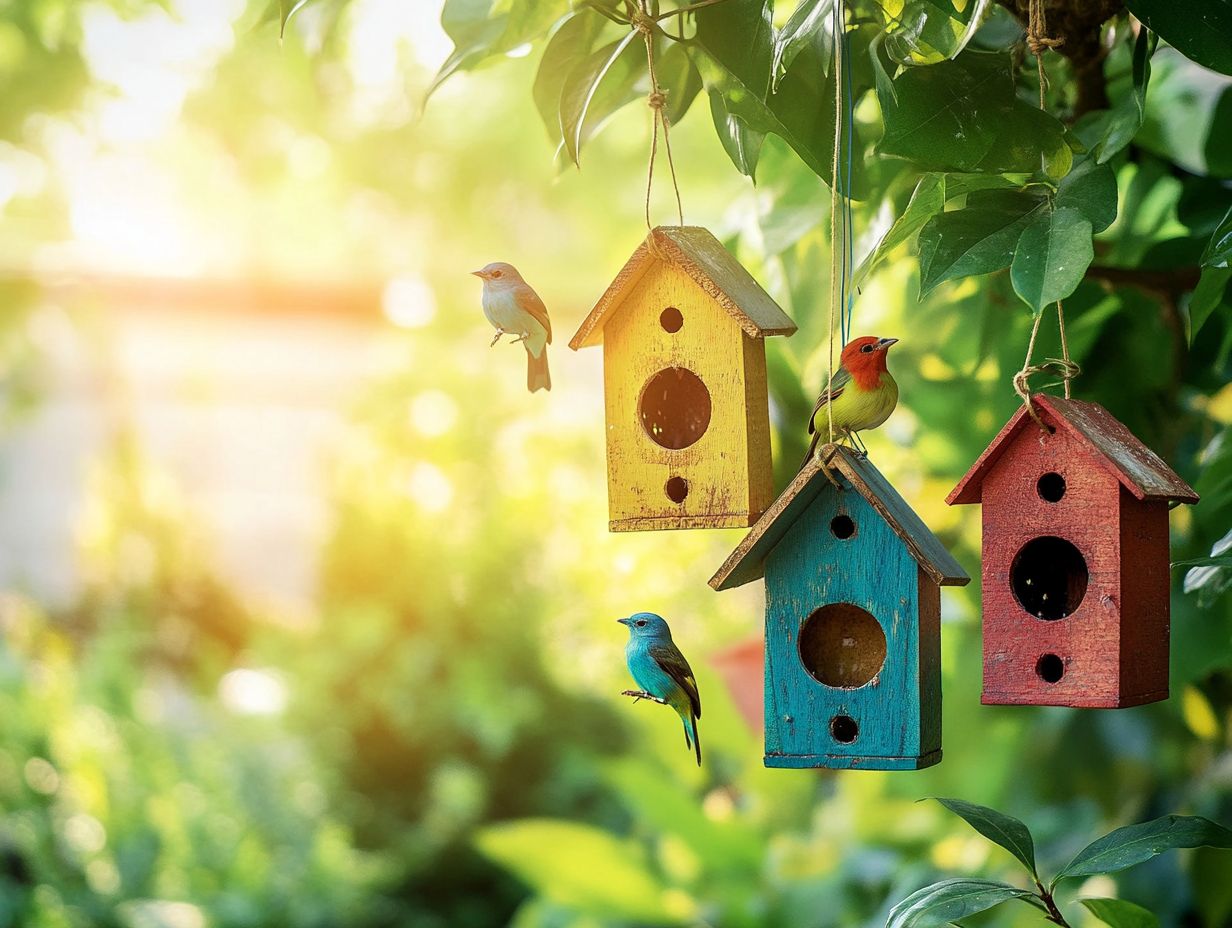Installing a birdhouse in your backyard is an excellent way to create a vibrant ecosystem at home. Attracting birds not only enhances the beauty of your garden but also contributes to local wildlife conservation.
This article explores the numerous benefits of birdhouses, offers tips for selecting the ideal location, and discusses the various types of birdhouses available.
Additionally, it provides a step-by-step guide for building your own birdhouse, suggestions for attracting feathered visitors, and maintenance advice to ensure your sanctuary thrives.
Whether you are an experienced birdwatcher or a curious beginner, you will find all the information you need to transform your outdoor space into a haven for birds.
The Benefits of Birdhouses

Building birdhouses offers several advantages, including providing birds with a nesting place, restoring habitats, enhancing community aesthetics, and serving as a creative and educational family project.
Birdhouses are manmade structures that offer shelter, allowing birds to nest and feed. By constructing birdhouses in your backyard, you create a healthy habitat for local birds while also improving the visual appeal of the community.
This DIY project promotes creativity and engages families, fostering a sense of care and concern for the environment in future generations. Additionally, birdhouses can help increase the local bird population, giving community members the opportunity to observe these beautiful creatures in their natural surroundings.
Why Attracting Birds is Important
Attracting birds to your backyard is vital for the ecosystem, as they serve as natural pollinators and pest controllers. Birds enhance biodiversity by regulating insect populations and effectively eliminating garden and crop pests.
When birds manage pests naturally, the need for chemical pesticides is reduced, thereby increasing the sustainability of gardening practices. Additionally, birds play a crucial role in pollinating many plants, which is essential for plant health and the overall well-being of the ecosystem.
Creating bird habitats with native plants and trees provides homes for various organisms, thereby strengthening the web of life that supports our ecosystems.
Choosing the Right Location
Selecting the right location for your birdhouse is essential to ensure the safety and comfort of the birds while promoting a thriving backyard habitat.
Key factors to consider include sunlight, wind direction, and proximity to feeding stations, all of which help create an inviting sanctuary for various bird species. A well-placed birdhouse can encourage nesting and increase the likelihood of attracting a diverse range of birds to your outdoor space.
Furthermore, it is crucial to choose a location that offers protection from predators and harsh weather conditions, as this is vital for the survival of local wildlife. These considerations not only enhance the aesthetics of your garden but also contribute to habitat conservation.
Factors to Consider

When choosing the placement of your birdhouse, several factors must be considered:
- drainage
- ventilation
- safety from predators
- proper nesting dimensions
First, adequate drainage is essential to prevent water accumulation, which can lead to mold growth and make birds uncomfortable. Second, proper ventilation is necessary to ensure adequate airflow, reducing the risk of overheating, especially during warmer months.
Additionally, it is important to consider safety from predators such as cats, raccoons, and snakes; therefore, the birdhouse should be located away from areas that these common predators frequently visit. Finally, the birdhouse should have appropriate nesting dimensions to accommodate the needs of the species you hope to attract. The interior dimensions must provide enough space for birds to build a nest and raise their young; insufficient space may deter them from nesting altogether.
By addressing these factors, you can create a positive environment for birds and increase the chances of a successful nesting season.
Types of Birdhouses
Birdhouse types are various styles designed to accommodate different bird species and their nesting preferences. These birdhouses can be constructed from materials such as wood, cedar, plywood, and other options.
Materials and Designs
The materials and designs used for birdhouses significantly impact their durability and suitability for various bird species, emphasizing the importance of sustainable and eco-friendly choices.
The selection of materials affects both the durability and aesthetics of the birdhouse. For instance, cedar is renowned for its natural weather resistance, ensuring that the homes remain intact in outdoor environments while providing a cozy habitat for birds.
Although plywood is a more affordable option that encourages more people to engage in woodworking, it typically requires a protective finish to enhance its longevity. Additionally, design features such as drainage and ventilation play a crucial role in the functionality of birdhouses, creating a comfortable living space that attracts a wider range of bird species.
Building Your Own Birdhouse

Constructing a birdhouse is an enjoyable DIY project that blends creativity with practical skills, while also offering a welcoming home for birds in your yard.
Step-by-Step Guide
Birdhouses can be constructed by following these steps while using appropriate materials and tools: measuring, cutting, drilling, assembling, and finishing. Throughout the process, safety and comfort for birds should be a priority.
- Measuring: Begin by measuring all pieces of wood before cutting them to the correct size. The width and height of the birdhouse should be suitable for the specific bird species you wish to attract. The size of the base should be proportional to the height and width, with a recommended starting point of 8 x 8 inches (20 x 20 cm) for the base. Additionally, the roof should be sloped and a minimum of 12 inches (30 cm) high to ensure proper drainage and ventilation.
- Cutting: Use a circular saw or table saw to cut the boards to the required dimensions. Be sure to measure and mark the boards accurately, as the cuts will be used to join the pieces together.
- Drilling: Drill entry holes that have a wide enough diameter for the desired bird species, but not so wide that they allow access to other animals, such as squirrels. These holes should be positioned about 6 inches (15 cm) from the bottom of the birdhouse. Ventilation and drainage holes should be small enough to prevent rainwater from entering, yet large enough to ensure adequate air circulation. As a general guideline, the entrance hole should measure between 1.5 to 3 inches (3.8 to 7.6 cm) in diameter, depending on the size of the bird, while ventilation holes should be between 0.5 to 1 inch (1.3 to 2.5 cm) in diameter.
- Assembling: Secure the pieces together using screws or nails, with a common recommendation of two screws or nails on each side of the corner joints. For smaller pieces, consider using three screws or nails on each corner. If you want the joints to last longer, apply wood glue before securing them. Once the glue has dried, you can apply primer or paint.
- Finishing: Use either a primer or paint to finish the birdhouse. A primer can help reduce the amount of paint needed, thereby minimizing exposure to harmful chemicals. Choose paint with low levels of Volatile Organic Compounds (VOCs).
Along with using the proper materials, birdhouses should be designed for easy maintenance. Depending on your country, there may be common practices for maintaining birdhouses. For example, in the USA, the National Audubon Society recommends cleaning birdhouses during the spring months. This involves removing any old nesting material and cleaning the inside with a diluted bleach solution. It is also important to check the entrance hole to ensure it remains the proper size.
Attracting Birds to Your Birdhouse
To attract birds to a new birdhouse, careful planning and a few key tips are essential to encourage nesting and foraging.
Tips and Tricks

These tips and tricks will help you create an environment that encourages birds to visit your birdhouse and make it their home.
Choose the Right Types of Plants: Native flowering perennials and shrubs that produce seeds or berries are most effective for attracting birds to your yard. Having a diverse range of plants is beneficial, as different species of birds have varying needs throughout the seasons. For example, pine trees are crucial for certain birds during winter, while flowering plants are most important in spring.
Select the Right Kinds of Feeders: Feeders filled with seeds, suet, or nectar provide essential nutrition for birds, encouraging them to return to your yard regularly. It is important to have a variety of feeders to cater to different bird species. For instance, hummingbirds are attracted to nectar, so including local flowering plants can enhance your chances of attracting them.
Incorporate Water Features: Birdbaths with clean water are an excellent way to entice birds to your yard. Some species, such as robins and finches, are naturally drawn to water and will visit more frequently if you provide it. By regularly changing the water, you create a welcoming spot for birds to stop by for a drink or a bath.
By combining these three elements—appropriate plants, diverse feeders, and water features—you will gradually establish a vibrant ecosystem filled with the delightful sounds of birdsong.
Maintaining Your Birdhouse
Maintaining birdhouses is essential for the health and safety of the birds that inhabit or utilize them. A regular regimen of cleaning and repairs not only ensures the well-being of the birds but also extends the longevity of the birdhouse itself.
Cleaning and Repairs
Cleaning and repairing birdhouses are essential practices for ensuring that they remain safe and inviting homes for birds throughout the year. Adhering to a rigorous maintenance schedule can significantly extend the lifespan of these small shelters.
Birdhouses should be cleaned at the end of each season using non-toxic, eco-friendly soaps and brushes to eliminate dirt and harmful parasites that may have accumulated. Basic cleaning can be done with regular tools like a soft-bristle brush, a bucket, and gloves.
Additionally, the structure should be inspected for any damage, as timely repairs not only maintain its structural integrity but also create a safer environment for birds. By following these practices, you can foster successful bird care and cultivate a thriving bird community around your home.
Creating a Bird-Friendly Environment
Landscaping for birds entails selecting plants, trees, and shrubs that provide food, shelter, and nesting sites. Additionally, it involves incorporating water sources and bird feeders to attract a variety of bird species to your backyard.
Planting Bird-Friendly Plants
Bird-friendly plants can significantly enhance a garden’s capacity to support local wildlife by providing nourishment and habitat for various bird species. Native plants play a crucial role in maintaining a healthy ecosystem, attracting not only birds but also a wide array of insects and pollinators.
Vegetation such as black-eyed Susans, echinacea, and elderberry are popular choices for bird-friendly gardens, as they produce seeds and fruits that feed birds throughout the year. Additionally, serviceberry, dogwood, and goldenrod offer cover, making them appealing to birds seeking nesting sites.
A diverse selection of plant types provides birds with shelter and food sources, while also aiding in natural pest control and enhancing the beauty of the landscape. By focusing on native plants, gardeners can promote biodiversity and contribute to the overall health of the local ecosystem.
Providing Food and Water Sources
Creating reliable food and water sources in your backyard is essential for attracting and sustaining bird populations, thereby fostering a vibrant, bird-friendly environment.
By incorporating various types of feeders—such as tube, platform, and suet feeders—you can cater to the unique preferences of different bird species. Selecting nutritious bird food, including seeds, nuts, and fruit, is vital to meeting their dietary needs.
Additionally, maintaining clean water sources ensures that birds have access to fresh drinking water and bathing areas, which are crucial for their health and hygiene. This combination of diverse food options and clean water not only supports avian health but also encourages a wider variety of birds to visit, creating an enchanting experience for any birdwatcher.
